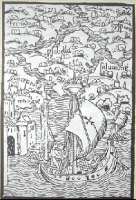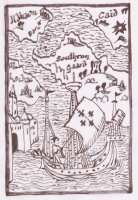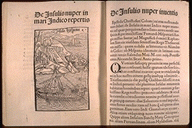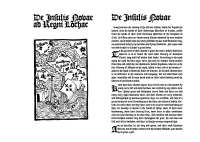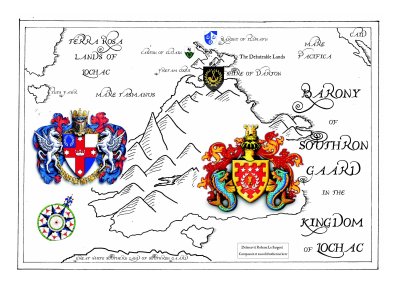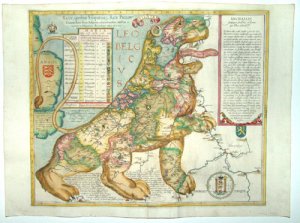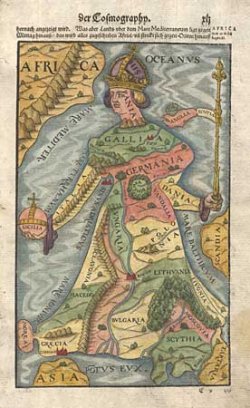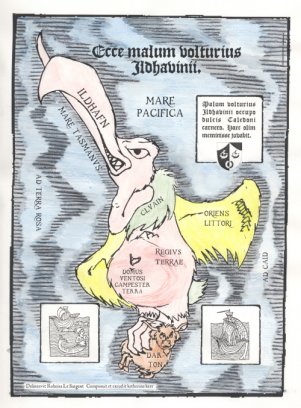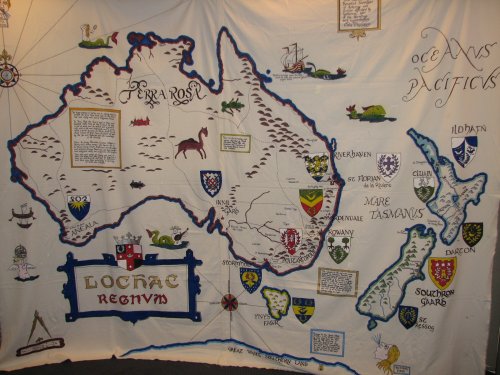 |
|
MapsAS50 Map Challenge: Mapping the Kingdom of Lochac from Large to Small:
[T-O and Zonal Maps]
[Itineraries and Route Maps]
[Local Maps]
[Isolario – Mapping Islands]
[Kingdom and World Maps] I have always found maps fascinating, and our household has a huge collection of atlases, map books and other cartographic paraphenalia. My original intent was to reproduce a local map in the style of Ortelius or Speed, but the interest and range has extended into much broader areas over the years. It's an interesting task, as we don't have any period maps of this region (some parts of our coastline have only just been updated from Cook's original soundings in the 1700s!). Early research saw me discover Timothy Pont, a young Scotsman who mapped a great deal of Scotland in the late 1500s. I've amassed a number of books issued by the National Library of Scotland as part of their Pont Project, and they were kind enough to send newsletters halfway around the world to keep me informed of what the project was up to. Having missed one chance to see the originals (an unexpected public holiday saw the map library closed the day I had spare in Edinburgh, argh!), I finally got to pore over them some years later. And yes, a Pont map is on my list. Another inspiration has been the History of Cartography project, headed by the Department of Geography at the University of Wisconsin. They too have kindly sent me their newsletter for a number of years as I (and many others no doubt) eagerly awaited production of their work. I now have the two huge tomes of Volume Three of the project's endeavours Cartography in the European Renaissance. There are bookmarks tucked throughout the volumes as part of my planning for an AS50 set of maps -- it's going to keep me busy for a very, very long time. In addition, I have working on the production side. While learning engraving has its appeal, I'm concentrating on electronic reproduction, whether from scratch or via initial manuscript production. This means I can print out multiple copies, make changes and issue new editions. It's a matter of deciding what is the best way to use these tools to achieve the effect I want. In the meantime, I'm studying a wide range of map styles with the intent of mapping the Known Worlde, and our part in it, from across the centuries. See the ever-growing set of maps in the AS50 Map Challenge. Columbus Letter: De Insulis Novae Ad Regni LochacWhen our lands shifted fom the Kingdom of Caid to the Kingdom of Lochac, we had a number of events to commemorate this, including a feast based on Columbus' return from the New World. I provided the menu design for the feast and, as part of that, decided to do a map that fitted the theme. A quick flurry of research produced information on the Columbus Letter De Insulis inuentis: Concerning the Discovered Islands.
The Basel edition of the letter includes a woodcut showing Columbus's arrival in the Caribbean, with the islands he named for his patrons represented in the background. These are often referred to as "the first cartographic images made by Europeans of the Old World", but are representative rather than actually map-like. It was once believed that the woodcuts were copied from drawings made by Columbus himself, but the caravel is a direct copy from Bernhard von Breydenbach's Peregrinatio in Terram Sanctam: Voyage to the Holy Land (Mainz, 1486). They are thought to have been created by a Swiss artist for the Basel edition of the Columbus Letter. I adapted the woodcut from the Basel Columbus Letter to tie in with our change of kingdoms from Caid to Lochac and the theme of the commemorating event celebrating Columbus return from the New World. Lack of time meant the production had to be a simplified line drawing; it will eventually be reworked as part of a series showing the evolution of maps. It shows the main lands and places of the Crescent Isles, and includes the Southern Cross on the sail. I used this on the cover of the feast menu and then later adapted it as part of a reworked facsimile of the Basel edition, with the page layout based on the Osher Map Library's reproduction of the Basel edition (imprint Johann Bergmann, April 21st 1494; folios 29v-30r).
The text of my work, noted below, follows very closely the letter by Christopher Columbus printed in the work, using the Osher translation from the Latin version, adapted as appropriate.The title has been changed to De Insulis Novae Ad Regni Lochac: Concerning the New Islands of the Kingdom of Lochac. Given Columbus' effusive reporting regarding the new lands, I thought it appropriate to follow suit, with the addition of a small anachronism identifiable to anyone who has seen the musical Camelot. One day I may assay a full version. The typeface is in JSL Blackletter, as developed by typographer Jeff Lee from period examples; it closely matches the title font of the Basel printing. I chose to use it as the text typeface also because I wanted to keep within the same font family and I haven't been able to locate a suitable matching font with support for ligatures and special characters. The Text of the De Insulis Novae LetterLong has been the coming of the Orient islands, found far beyond the waves, unto the hands of their Sovereign Majesties of Lochac, passed from the hands of their most Generous Majesties of the Kingdom of Caid. In this place are found many islands inhabited by men without number, all of which now are taken possession for our most fortunate king, as proclaimed latterly by heralds and flying standards. No region now can add further to Lochac's great deeds. To the greatest of these islands is given the name Insula Australia, wherein is to be found the most noble Barony of Southron Gaard, long held fast within these lands. Proceeding to the north along the coast for four days, there you will see another island distinct from this and called by its inhabitants Insula Aquilonis, wherein is the fair Barony of Ildhavn to the north, which is wet, and in the windy regions to the south is found the Shire of Darton. In all these islands there is no difference in the manners and language, but all understand each other mutually and so may speak with no little understanding with the subjects of mainland Lochac. The islands appear very fertile and are surrounded by many very safe and wide harbors, not excelled by any others to be seen. Many great and salubrious rivers flow and there are also many very high mountains there. All these islands are very beautiful, and distinguished by various qualities; they are accessible, and full of a great variety of trees stretching up to the stars. The bellbird and various other birds without number sing throughout the year, the rain does not fall until after sundown, and there is surely no more congenial spot. Therefore let the king and queen, and their most fortunate subjects, and all other countries of the Known Worlde, give thanks for so great a gift. Notes
Some excerpts from the edition of Columbus's letter entitled De Insulis inuentis, imprint Johann Bergmann, dated April 21st, 1494, in the possession of Osher Map Library, addressed to the most invincible King of Spain, from Christopher Columbus, Admiral of the Ocean Fleet: Because my undertakings have attained success, I know that it will be pleasing to you: these I have determined to relate, so that you may be made acquainted with everything done and discovered in this our voyage. On the thirty-third day after I departed from Cadiz, I came to the Indian sea, where I found many islands inhabited by men without number, of all which I took possession for our most fortunate king, with proclaiming heralds and flying standards, no one objecting. To the first of these I gave the name of the blessed Saviour, on whose aid relying I had reached this as well as the other islands. But the Indians call it Guanahany. I also called each one of the others by a new name. For I ordered one island to be called Santa Maria of the Conception, another Fernandina, another Isabella, another Juana, and so on with the rest. As soon as we had arrived at that island which I have just now said was called Juana, I proceeded along its coast towards the west for some distance; I found it so large and without perceptible end, that I believed it to be not an island, but the continental country of Cathay; seeing, however, no towns or cities situated on the sea-coast, but only some villages and rude farms, with whose inhabitants I was unable to converse, because as soon as they saw us they took flight.
And the said Juana and the other islands there appear very fertile. This island is surrounded by many very safe and wide harbors, not excelled by any others that I have ever seen. Many great and salubrious rivers flow through it. There are also many very high mountains there. All these islands are very beautiful, and distinguished by various qualities; they are accessible, and full of a great variety of trees stretching up to the stars; the leaves of which I believe are never shed, for I saw them as green and flourishing as they are usually in Spain in the month of May; some of them were blossoming, some were bearing fruit, some were in other conditions; each one was thriving in its own way. The nightingale and various other birds without number were singing, in the month of November, when I was exploring them. There are besides in the said island Juana seven or eight kinds of palm trees, which far excel ours in height and beauty, just as all the other trees, herbs, and fruits do. There are also excellent pine trees, vast plains and meadows, a variety of birds, a variety of honey, and a variety of metals, excepting iron. In the one which was called Hispana, as we said above, there are great and beautiful mountains, vast fields, groves, fertile plains, very suitable for planting and cultivating, and for the building of houses. The convenience of the harbors in this island, and the remarkable number of rivers contributing to the healthfulness of man, exceed belief, unless one has seen them. The trees, pasturage, and fruits of this island differ greatly from those of Juana. This Hispana, moreover, abounds in different kinds of spices, in gold, and in metals. On this island, indeed, and on all the others which I have seen, and of which I have knowledge, the inhabitants of both sexes go always naked, just as they came into the world, except some of the women, who use a covering of a leaf or some foliage, or a cotton cloth, which they make themselves for that purpose. In all these island there is no difference in the appearance of the people, nor in the manners and language, but all understand each other mutually; a fact that is very important for the end which I suppose to be earnestly desired by our most illustrious king, that is, their conversion to the holy religion of Christ, to which in truth, as far as I can perceive, they are very ready and favorably inclined. In all these islands, as I have understood, each man is content with only one wife, except the princes or kings, who are permitted to have twenty. The women appear to work more than the men. I was not able to find out surely whether they have individual property, for I saw that one man had the duty of distributing to the others, especially refreshments, food, and things of that kind. I found no monstrosities among them, as very many supposed, but men of great reverence, and friendly. Nor are they black like the Ethiopians. They have straight hair, hanging down. They do not remain where the solar rays send out the heat, for the strength of the sun is very great here, because it is distant from the equinoctial line, as it seems, only twenty-six degrees. On the tops of the mountains too the cold is severe, but the Indians, however, moderate it, partly by being accustomed to the place, and partly by the help of very hot victuals, of which they eat frequently and immoderately. Southron Gaard Map, the firstWhen my lord and I became Baron and Baroness of Southron Gaard (AS39), it seemed only fitting that we introduce ourselves to our new Baronial Cousins throughout the Kingdom of Lochac. Naturally we wanted to show them the extent of the lands of Southron Gaard, so I adapted a drawing done in the early days of the Shire by Mistress Roheisa le Serjent. For some reason, a number of our dear Cousins objected to it.... Here's the map:
And the text that went with it: Let all know to whom these present letters come. Ecce malum volturius IldhaviniiWe received a delightful riposte to the Southron Gaard Map from our dear neighbours to the north, courtesy of the hand of their most excellent cartographer Lord Benedict of Askerigg. It involved his usual careful depiction of a portolan-style map, with a large compass rose strategically placed over the top of our lands, blotting them from the face of the Known Worlde. Such a conceit could not go unanswered.... The Ecce malum volturius Ildhavinii map was thus born. It has been based upon the period practice of taking a geographical area and representing it as a figure or animal that possesses some relationship to the region presented. One of the most famous period examples of this practice is the Leo Belgicus series, whereby Belgium and the Netherlands were portrayed as a stately lion uniting the 17 provinces of the Low Countries, then under Spanish rule. The lion was a common element on local regional arms, hence its choice.
This series, which went through a variety of editions, began in 1583, when the Austrian cartographer Michael Aitzinger first depicted the country in this fashion. The example here is Aitzinger's 1583 version (Leo Belgicv; Michaelis Aitsingeri Austriaci ad leonem pro lectore introductio), although the idea was used by many cartographers thereafter throughout the first half of the 1600s. Another cartographic oddity of this type is a map by Sebastian Munster in his Cosmographia Universalis (ca 1580), depicting Europa Regina, the countries of Europe in the form of a crowned woman with an orb and sceptre. An earlier, more complex, example was drawn up by Johannes Bucius in 1537. Some cartographers have argued that Munster's version is intended to represent Charles V of Spain, as Hispania forms the head and crown of Europe. In the case of Malum Volturius Ildhafinii, the shape of the North Island lent itself to a suitably symbolic depiction of the Barony of Ildhafn, and the much cuter depiction of the Shire of Darton, known for the fearsomeness of its dreaded coo beasties.
The map has been set and hand-coloured with watercolour pencils along the lines of Munster's Europa Regina, which is a much simpler approach artistically to that of the Belgium lion. The fonts are Bucaneer and JSL Blackletter, which are both based on fonts in or close to in period. The R in the labels are Quasimodo, chosen to match the dropped descender used in Europa Regina. Part of the problem with any historic mapping of New Zealand is that there are far fewer places to label on a local map in an SCA context than are typically present on period maps, leading to a much sparser look or the need to add or modify labels. The map labels indicate Regius Terrae, or Crown Lands, which separate the Barony of Ildhafn and the Shire of Darton; contained within these is Domus Ventosi Campester Terra, referring to the Household of the Windy Plains, the far-flung residence of long-term member Lady Cynethryth the Dutiful; and the Oriens Littori is the East Coast. The mountains and the "belly-button" of Lake Taupo are all depicted in period fashion. I've tried adding more decorative elements with the woodcuts referencing the lymphad to be found on Ildhafn's arms and the text box, as per the Leo Belgicus map decorations. The Latin reads, in rough translation The evil vulture of Ildhafn seizes the sweet Scottish cow and then segues into a quote from Virgil's Aeneid: Perhaps, we'll look back at this and smile. Kingdom MapI knew that for Midwinter Coronation we would need to be able to cover a large amount of space in the Feast Hall. That, combined with having my interest piqued by the background map-painter in The Pirates of the Caribbean III, led me to think about producing a large map painted on cloth. Such a large map would need a large subject, and we had one in the form of the Kingdom. Lord Benedict Stonhewr of Askerigg was kind enough to let me base my painted cloth on his artwork and so began many nights of sitting painting all manner of images after sifting through the many map books in my collection. I didn't really get a good feel for how the whole thing looked, as the table I was using allowed only a small amount visible at any one time, but I was pleased with the final results.
The map was first used at Canterbury Faire AS41 and it was gratifying to see many people stop and look at it where it hung in the Feast Hall. It's another element that helps to make us a part of one Kingdom. May Crown Tourney AS41 saw Painted Cloths as a Kingdom A&S category and, as this was within my year-and-a-day A&S geas, I lugged the map over to Politarchopolis. I need to complete it with a nice velvet border in blue and red a la the bars around period maps. Here follows the formal documentation I wrote up on both the approach and the map iself. Who fears a sentence or an old man's saw Painted or "stained" cloths were a relatively cheap way in period of covering areas of wall with something both interesting, on occasion illuminating, not to mention insulating. It was with the first two aims in mind that I undertook the idea of producing a large-scale wall map as a means of:
ClothMost painted cloths that I can find reference to, as in Gordon and others, were produced on finely woven silk (sendal) or linen (sindon). England and Germany have numerous recorded examples of linen painted cloths being used for interior decoration. Canvas was typically chosen for uses that required greater durability, such as portraits being shipped across Europe or large-scale works. Maps painted on cloth had a long history, with Edward I of England having a cloth mappamundi in his inventory of 1299-1300, according to Kupfer, who goes on to note that "fabric appears to have become an increasingly common support for cartographic images in the fifteenth century" citing such maps in the possession of Rene of Anjou and Pope Pius II. This type of map is the forerunner to the late-period map I have attempted, but a late hand-painted cloth map seemed reasonable as, in any case, English cartographers didn't start producing printed maps until after the 1570s (English Maps, pg 56). I used a fine cream wool as it was the cheapest material available to me in bulk (yes, really! $2/m), and the nearest fabric approximation I could find to the high-rag content paper that was used in the large-scale printed wall maps (1.7 x 1.5m on 20 sheets) of the later 1500s produced by cartographic publishers such as Blaeu, Speed and others. I wanted to use fabric for this later period style of map rather than paper primarily because it is much more durable. The close weave of the wool surface is comparable to that of canvas, but less inclined to allow the paint to bleed. The fact that the wool had been additionally treated with fire retardant also appealed, given its intended use as a hall wall-covering, and could be seen as a modern version of the gesso treatment the Italian artist Cennini recommended for linen to help produce a clean, smooth surface on which to paint. Painted cloths were not necessarily restricted to simple wall hangings. A large circular banqueting hall, 100 metres in circumference, was produced for an English court event in 1581, consisting of canvas walls painted to look like stone and a roof painted with clouds and stars (Gordon). Henry VIII had large painted cloths depicting maps of Europe and the constellations: By his death in 1547, the walls of his palaces were covered with 'painted cloth' (a cheaper version of tapestry decoration) containing maps and cartographical depictions of some sort.
Paints and TechniqueThe 15th-century Italian artist Cennino Cennini produced a reference text, Il Libro dell'Arte (The Craftsman's Handbook), which provides instructions for painting on linen or silk. He worked with gesso, glair and tempera, as well as gold leaf, and recommended varnish as a means of providing waterproofing, especially for products liable to be displayed outdoors. His approach was to draw his outlines in charcoal, then to later ink them in using a fine "minever" brush to produce shading and shadows: When you have finished drawing your figure, especially if it is in a very valuable ancona, so that you are counting on profit and reputation from it, leave it alone for a few days, going back to it now and then to look it over and improve it wherever it still needs something.... That's good advice, which I took to heart throughout the project. The main outlines of the map were projected on a wall (a technique not unknown in period, with pinhole projection used by various Renaissance painters to assist in the production of large-scale work) and drawn in with pencil, to be later inked in with allegedly waterproof marker pens for detailing and control. I used Fastex textile ink (comparable to acrylic paint) as I required a medium that was readily available and which could be rendered colour-fast. Its nearest period equivalent in this context would be tempera, as it produces a similar matte opaque covering which shows relatively little in the way of brushstrokes. Some additional detailing was added in with pen, again a technique espoused by Cellini to improve the detail and quality of the result. Flemish map engravers, working in England as well as on the Continent, were keen to use large areas of brilliant colours on their engraved maps (Lynam, pg 50). I've used the common technique of outlining the edges of the coasts, both land and sea, in a range of colours, keeping to the period conventions of colouring towns in red, mountains in green or brown, bodies of water in blue -- except the Terra Rosan rivers which are, naturally, brown (see Waldseemuller's 1516 Carta Marina and other examples in Remarkable Maps, pg 114, and The Image of the World, pg 54). Bear in mind that you may copy and examine things done by other good masters; that it is no shame to you. I've borne in mind Cennini's helpful words and gained permission from Lord Benedict of Askerigg to use his Kingdom map as the basis of this work, as indicated in the period-style acknowledgement box at the map's top right. Many maps had lists of credits for those who had worked on the maps, including the original mappers, engravers, colourists and the like -- it was not a period practice for an individual to be expected to produce the whole thing from start to finish. As the work progressed, I modified it extensively, which caused some problems in terms of dealing with the initial pencilled outlines which proved stubbornly difficult to eradicate. The main aspects used from the original are the outlines of the lands involved, the font Benedict used for the baronies' names, and a few of the incidental images (such as the merman, the large fish and the ship). The map has largely been decorated in a style most closely representing the work of the renown European cartographer Abraham Ortelius, whose maps were published in the latter half of the 16th century. Ortelius is regarded as the father of the modern atlas, and compiled many maps from a large variety of cartographers. Other influences on this map include his contemporaries including Hondius, Mercator, John Speed, Waghenaer and Gutierrez, who all tended to borrow from each other. Lettering Text The area noted "Beach" was captioned as such in a number of late-period maps by van den Keere, Ortelius, Mercator and the like (Landmarks, pgs 110, 246). It is usually found as a land label on the other side of the peninsula from the area labelled "Lucach", so seemed fitting to include. The I. de Bartolomaeus is an imaginary island drawn in and named for my lord (he picked a nice sunny part of the coastline from where he could watch the sunset). It wasn't unknown for cartographers to ink in a rock or island in a far-away area and name it after their wives, so I'm just following period practice…. Cartouche Scale Compass Winds Ship and Whale It was I who circled the world. By right am I called Victory; mine are the sails and the wings, the prize and the glory, the struggle and the sea. Merfolk and Other Creatures The wee cherub carrying an armillary sphere on his shoulder is from a map by Hondius (Landmarks, pg 74). Lynam refers to a cherub "infestation" to be found on later maps (pg 50), and I figured one was more than ample as they do have a tendency to look more 17th-century than 16th. The depictions of the creatures on the main land mass are comparable to the sketches found on maps of Africa and South America, which often had drawings of animals and relevant information about them. The actual drawings have been taken from an earlier manuscript, a 14th-century Bodlean bestiary (Barber). And you come out with such a handsome drawing, in this way, that you will make everyone fall in love with your productions. I hope that this work will achieve the stated aim of Cennini, not for my own sake (as he was advising on how one should go about gaining greater patronage), but for the better knowledge of the Kingdom that I hope it inspires.
| ||||||||||||||||||||||||||||||||||||||||||||||||||||||||||||||
